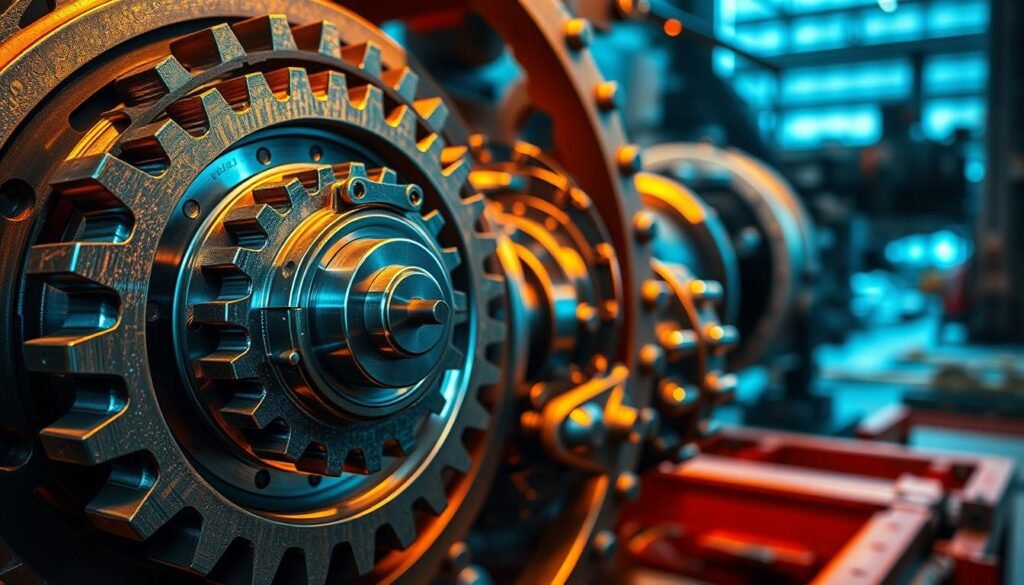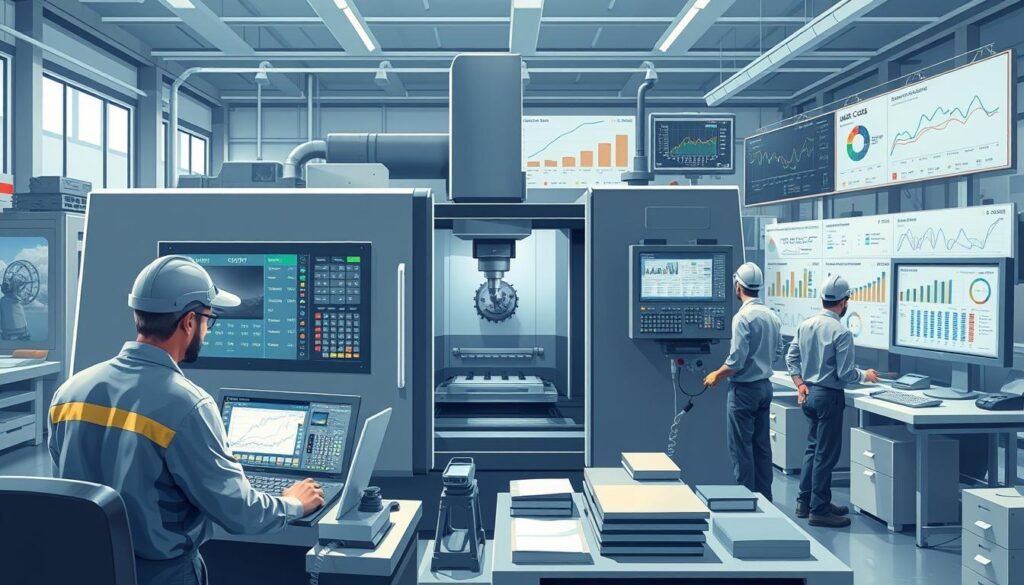Getting the cost right is key for CNC projects in manufacturing. Knowing how to estimate costs in CNC-Bearbeitung is vital. This guide helps you make smart budgeting and operational choices.
Many things affect project costs. These include the materials used, how complex the design is, and the machining methods. For instance, sheet metal forming has its own cost factors. By exploring these, we aim to improve your grasp of Kosten für CNC-Bearbeitung. This will make your project estimates more reliable.
Wichtigste Erkenntnisse
- Understanding the various factors influencing cost estimation is crucial for project success.
- Auswahl des Materials, design complexity, and machining techniques significantly impact costs.
- Accurate budgeting helps streamline operations and improves overall efficiency.
- Professionals should consider all financial aspects of CNC-Bearbeitung for informed decision-making.
- Implementing effective Fertigungslösungen can reduce costs and enhance productivity.
Understanding CNC Machining Costs
Kosten für CNC-Bearbeitung are key to any manufacturing budget. These costs can change a lot based on several factors. For example, CNC services cost $100 to $200 an hour in North America and Western Europe. But in China, they can be as low as $20 to $50 an hour.
This price difference mainly comes from labor costs and local demand. Different machining methods also affect costs. Milling and turning might cost $75 to $150 an hour. But EDM, a more complex method, can cost up to $300 an hour.
How precise you need the parts also matters. Parts with standard tolerances cost less. But parts needing tighter tolerances can cost 20-30% more. This is because they need more setup and inspection time.
The material used in CNC-Bearbeitung also affects costs. Aluminum costs $2 to $5 per pound, while titanium is $10 to $25 per pound. Stainless steel is usually around $3 to $10 per pound. Harder materials need special tools and take longer to machine, raising costs.
How complex the part design is also important. Simple parts cost $100 to $300. But complex designs can cost $1,000 or more. This is because they need more programming and machining time.
Producing more parts at once can also change costs. Making 1-10 parts can cost $500 to $1,500 per unit. But making 100+ parts can lower costs to $10 to $50 per unit. This is because of economies of scale.
The surface finish you want can also add to costs. Basic finishes don’t increase prices. But special finishes like anodizing or powder coating can cost $1 to $10 per part. Extra finishing steps can also increase lead times and labor costs.
Lastly, the reputation of the service provider matters. Top providers with advanced tech and skilled staff might charge more. But they usually offer better quality and faster service.
Factors Influencing CNC Project Costs
Knowing what affects CNC costs helps with planning. Where you are matters a lot. CNC services in North America and Western Europe cost $100 to $200 an hour. But in Asia, like China, it’s $20 to $50 an hour. This is because of labor, overhead, and demand differences.
The CNC method you pick also changes costs. Simple tasks like milling or turning cost $75 to $150 an hour. But complex tasks like EDM can cost up to $300 an hour. It’s key to pick the right method for your project.
How precise you need your parts also affects the cost. Standard tolerances are affordable. But tighter tolerances mean more setup and checks, costing 20-30% more. This is because high-precision work needs better machines and skilled workers.
What material you choose also matters. Aluminum costs $2 to $5 per pound, while titanium is $10 to $25. Specialty materials like stainless steel cost $3 to $10 per pound. Harder materials need special tools and more time, raising costs.
The CNC service provider’s reputation can also raise costs. Top providers with the latest tech and skilled staff might charge up to 50% more. But you get better quality and faster service.
The part’s complexity affects its cost. Simple parts cost $100 to $300. But complex designs can cost over $1,000 per part. This is because they need more time and effort.
How many parts you need to make is also important. Making 1-10 parts costs more, $500 to $1,500. But making over 100 parts can cost as little as $10 to $50 each. This is because of the savings from making more.
Choosing the right finish for your parts is crucial. Detailed finishes cost more because they need extra steps and tools. But simpler finishes are cheaper. Planning carefully helps match your needs with your budget.
Material Selection for CNC Projects
Choosing the right material is crucial for CNC projects. Different materials affect how fast and well things can be made. They also impact the cost over time. By looking at different materials, we can see how they affect our budget and how long things take.
Comparing Costs of Different Materials
Bei der Kommissionierung von Materialien für CNC projects, cost and quality matter. Here’s a look at common materials and their prices:
| Material | Cost per Kg | Eigenschaften | Gemeinsame Anwendungen |
|---|---|---|---|
| Aluminium | $5 – $20 | Lightweight, highly machinable | Luft- und Raumfahrt, Automobilindustrie |
| Baustahl | $1 – $5 | Durable, affordable | Strukturelle Komponenten |
| Rostfreier Stahl | $15 – $50 | Corrosion-resistant, strong | Medical devices, food processing |
| Specialty Metals | $30 – $100+ | High-performance, specialized | Aerospace, high-temperature applications |
| Kunststoffe | $2 – $5 | Versatile, lightweight | Consumer goods, electronics |
High-Performance Alloys vs. Common Metals
High-performance alloys cost more than common metals. But they offer special benefits. For example, Titanium and Inconel are strong at high temperatures and resist corrosion well.
On the other hand, metals like aluminum and mild steel are cheaper. They’re good for quick projects that don’t need special materials. Knowing the differences helps us choose wisely for our CNC projects.
Design Complexity Impacting Costs

Design complexity can greatly affect the cost of CNC machining projects. It often means longer machining times and the need for advanced tools. For companies looking to improve their CNC processes, understanding this link is key.
Importance of Simplifying Designs
Making designs simpler can save a lot of money in CNC manufacturing. Simplifying designs helps in optimizing CNC processes, cutting down setup times and resource use. Working with skilled design engineers early on is important.
They can offer insights that balance function with cost. Some benefits of simpler designs include:
- Unter tooling costs due to fewer specialized tools required
- Reduced waste during the machining process
- Shorter production cycles allowing for faster time to market
- Minimized errors and higher consistency in final products
Focus on design simplicity makes machining processes smoother. It also helps in making projects more profitable.
Machining Time and its Effect on Costs
Verstehen machining time is key to knowing CNC project costs. It shows how long it takes to make each part. It also shows how cycle and setup times affect the budget. Managing machining time well can make CNC production more efficient.
Cycle Time and Setup Time Considerations
Cycle time is how long it takes to finish one job on a CNC machine. Setup time is how long it takes to get ready for a new task. Both are important for figuring out machining time and costs.
Short cycle times mean more parts can be made in less time. Less setup time means less time waiting between jobs. Knowing these times well helps cut costs.
| Faktor | Auswirkungen auf die Kosten | Strategies for Optimization |
|---|---|---|
| Cycle Time | Longer cycle times increase power consumption and tool wear, leading to higher costs. | Implement high-speed machining and efficient tool selection. |
| Einrichtungszeit | Excessive setup time can lead to underutilization of machine capabilities. | Use standardized setups and invest in modular tooling. |
For more detailed insights on managing Kosten für CNC-Bearbeitung, we encourage you to explore factors that influence CNC machining expenses. This knowledge can aid manufacturers in achieving cost-effective and efficient production.
Tooling Costs in CNC Machining

In der CNC-Bearbeitung, tooling costs are key. They cover buying, keeping up, and replacing CNC-Schneidwerkzeuge. The quality and state of these tools greatly affect how well things get made and how much it costs.
By choosing the right tools and keeping them in good shape, makers can save money. This leads to better work and more savings.
Purchasing and Maintenance of Cutting Tools
Buying top-notch CNC-Schneidwerkzeuge is worth it. They last longer and work better. Even though they cost more upfront, they save money in the long run.
Tools for hard materials or tricky jobs need to be replaced more often. Keeping track of tool wear and replacement costs helps makers decide when to swap them out. This ensures tools work well without wasting resources.
Don’t forget the importance of regular tool upkeep. Skipping this can cause more downtime and lower efficiency. A set maintenance schedule keeps tools running smoothly and reduces the chance of sudden breakdowns.
| Werkzeug-Typ | Initial Cost ($) | Maintenance Frequency | Average Lifespan (Hours) |
|---|---|---|---|
| End Mill | 100 | Every 100 hours | 300 |
| Drill Bit | 50 | Every 50 hours | 150 |
| Turning Tool | 150 | Every 200 hours | 500 |
Being proactive with maintenance and thinking about long-term costs helps CNC makers manage tooling expenses. For more tips on controlling these costs and boosting CNC machining efficiency, check out our detailed guide on Kosten für CNC-Bearbeitung.
Volume and Batch Size Considerations
Die production volume und batch size are key to making CNC machining projects efficient and cost-effective. By optimizing these, you can save a lot and make your CNC manufacturing efficiency besser.
Big batch sizes make each part cheaper because fixed costs are spread out. This means you use resources better and save on setup time. For example, making 1,000 parts instead of 100 means setup costs are spread over more parts, saving money overall.
But, small batch sizes can make each part more expensive because setup costs don’t change. This means you have to think carefully about how many parts to make. Finding the right batch size is important for keeping things running smoothly and meeting market needs.
| Größe der Charge | Produktionsvolumen | Kosten pro Einheit |
|---|---|---|
| Small (100 units) | 100 | $15.00 |
| Medium (500 units) | 500 | $10.00 |
| Large (1,000 units) | 1,000 | $7.50 |
In short, knowing how production volume und batch size affect costs is crucial for improving CNC manufacturing efficiency. Making smart changes in these areas helps with budgeting and success in operations.
Labor Costs in CNC Operations

Verstehen labor costs in CNC operations is key for any manufacturer. It helps them manage their budget better. Labor costs include wages and extra expenses for hiring erfahrene Anwender. These costs change based on the project’s complexity and the skill needed for precise results.
Skilled Operators’ Impact on Budget
Skilled operators are very important. Their knowledge affects how well and efficiently CNC machines work. By investing in skilled labor, you can lower mistakes, waste, and rework costs.
- Expert Programming: Skilled operators know how to program CNC machines well. This cuts down on downtime and boosts productivity.
- Complex Projects: Projects with complex designs need more time and special knowledge. This affects labor costs.
- Qualitätssicherung: Experienced operators make sure products meet high quality standards. This lowers the chance of failure.
Finding the right balance between skilled operators and budget is tough. Smart hiring and training can improve your CNC workforce. This keeps production standards high while keeping costs in check.
Waste Management and Costs
Gut waste management is key for companies to save money in CNC operations. Bad machining can cause a lot of waste, leading to higher costs.
Working on reducing waste can really help a company’s budget. By cutting down on waste, companies save resources and make CNC work better. Making things right the first time means less waste and lower costs.
Quality control is very important for managing waste. Making sure things are precise and follow the design helps avoid mistakes. Using good machines and training workers well means less waste and less money spent.
| Strategie | Beschreibung | Auswirkungen auf die Kosten |
|---|---|---|
| Feinmechanische Bearbeitung | Using advanced tech for accurate cutting and shaping. | Significantly reduces scrap and rework costs. |
| Quality Control Checks | Regular checks to catch errors early. | Minimizes waste from faulty parts. |
| Bedienerschulung | Skilled operators ensure efficient and correct machining. | Improves CNC efficiency and reduces waste. |
Sheet Metal Forming in CNC Projects

Sheet metal forming is key in CNC projects. It’s a big part of Metallherstellung. It includes bending, stamping, and shaping metal sheets.
Gewusst wie CNC sheet metal production works helps us choose the right materials and methods. This knowledge can lower costs and improve productivity. It makes sure our projects meet our goals.
The thickness, type of metal, and forming method all matter. They affect how well and fast we can make a product. By focusing on sheet metal forming, we can cut down on waste and make our products more accurate.
Reducing CNC Machining Costs
Lowering CNC machining costs is key to making operations better. Using different strategies can make CNC work more efficient without losing quality. Here are some important ways to do this.
Strategies for Cost Optimization
- Simplify designs: Making part designs simpler can cut down on costs. Working with machinists early can avoid expensive changes later.
- Select materials wisely: Picking materials that are affordable but still good can save money. Materials that are easy to work with also save time and tools.
- Invest in durable tools: Choosing the right tools and keeping them in good shape means less need to replace them. Regular care keeps tools working well for longer.
- Optimize CNC programs: Making tool paths more efficient and cutting down on idle time can save a lot of time. Standardizing setups also saves time and money.
- Produce in larger quantities: Making more parts at once can spread out setup costs. Planning production well and grouping similar jobs can also save money.
- Maximize machine utilization: Finding and fixing reasons for idle time can make machines work more. Regular maintenance and using multi-tasking machines can save money in the long run.
- Enhance operator training: Keeping operators well-trained can make them work more efficiently. Automating tasks can also save on labor and improve quality.
- Implement monitoring systems: Using sensors to check parts during production can catch problems early. This can save on waste and rework. Using Statistical Process Control can also help make improvements.
- Utilize energy savings: Setting machines to save energy and running them when it’s cheaper can lower bills.
- Negotiate with suppliers: Working with suppliers over the long term can make things cheaper. Using new technologies can also save money and reduce maintenance.
Schlussfolgerung
This guide has shown us what affects CNC project costs. We learned about material choice, labor, and waste. These insights help us plan budgets better for CNC projects.
Knowing how to make design choices and pick the right tools can save a lot of money. Making designs simpler and choosing the best materials are key. Every maker can use budgeting tips for quality and saving resources.
It’s important to balance cost and quality for a project’s success. With what we’ve learned, makers can handle CNC project costs better. This improves their work efficiency.
FAQ
What factors contribute to the cost estimation of CNC projects?
Many things affect CNC project costs. These include the material used, how complex the design is, and how long it takes to machine. Costs also depend on the tools needed, how many items are made, labor, and waste management.
Wie wirkt sich die Materialauswahl auf die Kosten der CNC-Bearbeitung aus?
The material you choose greatly affects costs. Some materials, like high-performance alloys, last longer but cost more. Knowing which materials work best for your needs can save money.
Why is design complexity important when estimating CNC project costs?
Complex designs need special tools and take more time to set up. This makes them more expensive. Simple designs can save a lot of money.
How do machining time and costs correlate?
The time it takes to machine something directly affects costs. Longer times mean more power used and tools worn out. This raises costs.
What are tooling costs, and how do they affect CNC operations?
Tooling costs are for buying, keeping, and replacing tools for CNC work. The life and quality of these tools greatly affect how efficient and cost-effective production is.
How does batch size affect CNC machining costs?
Making more items at once lowers costs per item. But making fewer items costs more because of setup times. Finding the right batch size can help manage costs.
What role do labor costs play in CNC machining?
Labor costs are a big part of CNC expenses. Skilled workers are needed for programming and running CNC machines. More complex projects need more skilled workers, affecting costs.
How can effective waste management help in reducing CNC project costs?
Good quality control and precise machining reduce waste. This saves money and makes operations more efficient.
What is sheet metal forming, and how does it relate to CNC machining costs?
Sheet metal forming includes bending and stamping metal. Knowing these processes helps choose materials and machining methods wisely. This can lower costs.
What strategies can be employed to reduce CNC machining costs?
To cut costs, focus on simpler designs, the right materials, and faster machining. Also, manage tools well and reduce waste. These steps can help save money.


